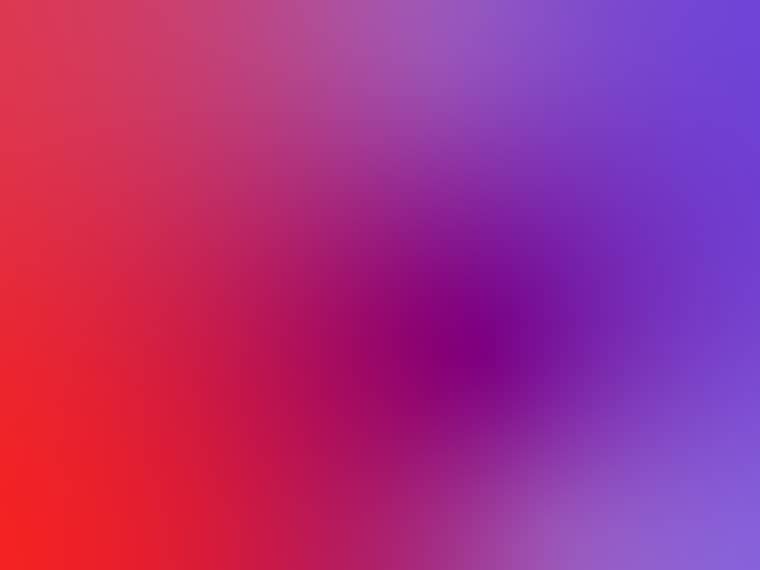Red and purple are among the color wheel’s most beautiful and powerful colors. But what happens when you mix red and purple?
In today’s article, we will answer a great curiosity: “Red and purple make what color when mixed?”
Red and purple have many things in common besides a lot of red. Red is a primary color on the color wheel.
On the other hand, purple is a secondary color created by mixing red and blue in equal quantities.
Even in terms of color meanings, they have some associations. For example, the color red is associated with strength, passion, courage, and energy; The color purple, on the other hand, is the color of royalty, symbolizing power, ambition, mystery, and creativity.
However, while purple is more grounded in the spiritual world, red likes to live in physical reality.
What Color Do Red and Purple Make When Mixing Paint?
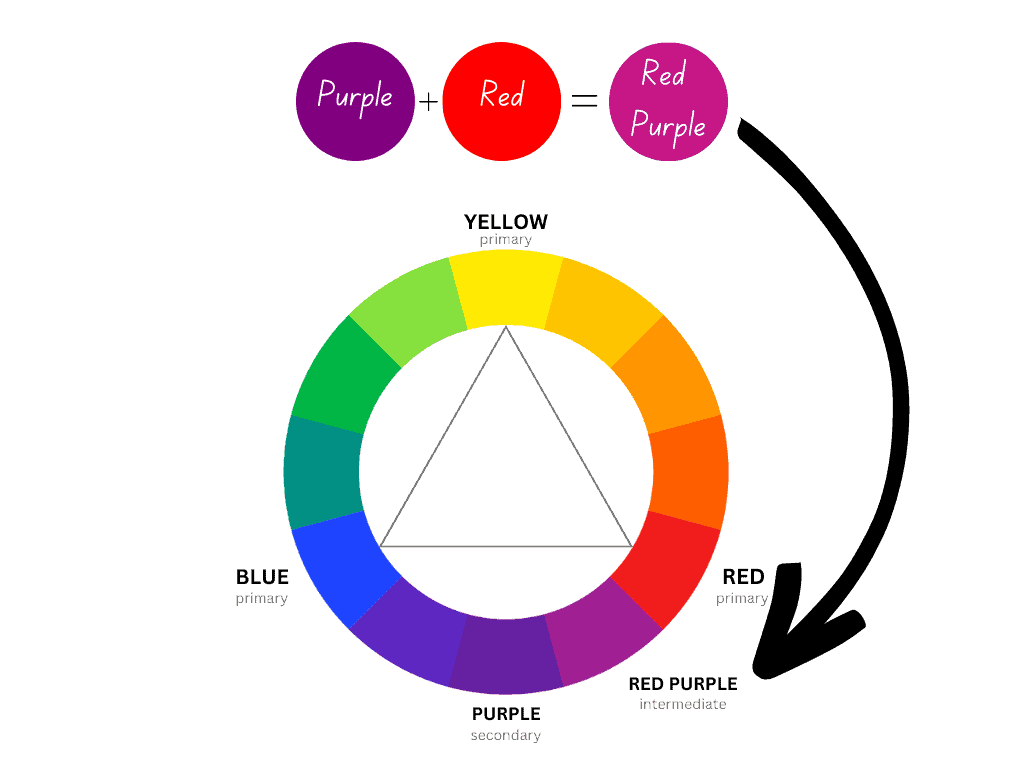
If you mix red and purple paint together, you’ll get red-purple or red-violet, which is an intermediate color. It is a warm shade of purple, but many artists call it magenta.
So what do you get if you mix red and purple?
When red and purple are mixed, they produce a warm shade of purple. That’s because purple is a secondary color made by mixing blue and red. So, mixing purple and red is like mixing one-part blue with two parts red.
Purple is a secondary color on the traditional color wheel and comes in different shades. Even though purple is generally a cool color, like blue, mixing purple and red makes a warm purple.
Every color carries a bias. For example, some may have a cold bias, while others may have a warm bias.
So, while blending blue and red results in a cool purple, red and purple mixed together make a warm purple.
Is Red-Purple an Intermediate or a Tertiary Color?
Red-purple is an intermediate color, not a tertiary color, because, in art, the mixtures between a primary color and an adjacent secondary color are called intermediate colors.
Tertiary colors, however, are mixtures of two secondary colors.
What are Intermediate Colors?
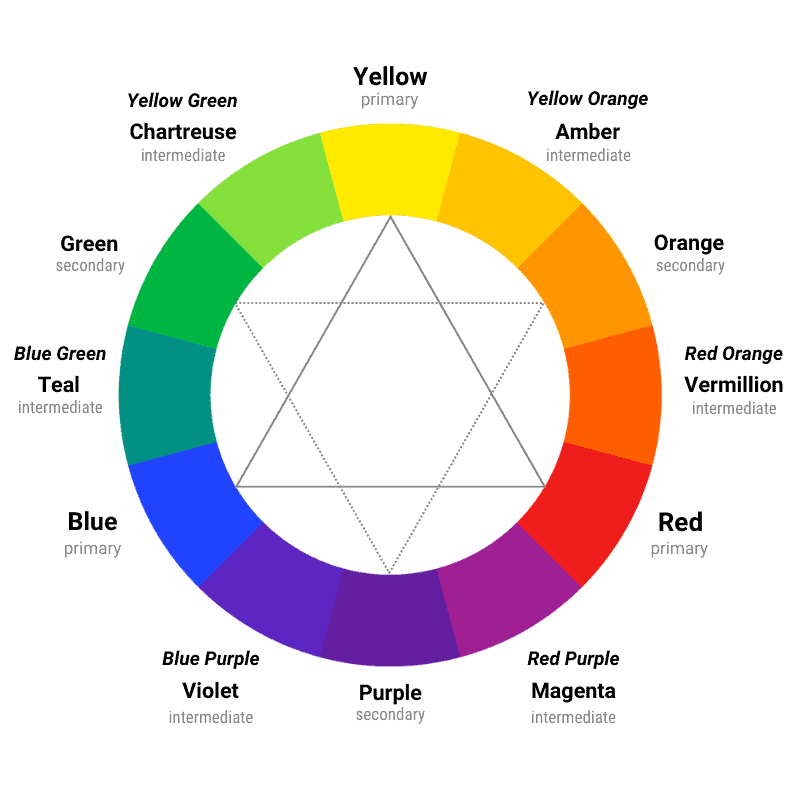
Intermediate colors are equal mixtures of a primary color – red, yellow, or blue, and an adjacent secondary color.
There are six intermediate colors on the RYB color model: yellow-orange, red-orange, red-purple, blue-purple, blue-green, and yellow-green.
Thus, their names show us what colors are mixed to create them.
The six intermediate colors on the color wheel can be named as such:
- Yellow-orange: Amber
- Red-orange: Vermillion
- Red-purple: Magenta
- Blue-purple: Violet
- Blue-green: Teal
- Yellow-green: Chartreuse
Although many confuse intermediate and tertiary colors, they are not the same.
Tertiary colors are equal mixtures between two secondary colors. So, a tertiary color is any two-color mixture of green, orange, and purple.
However, this definition of tertiary colors only applies in traditional art. In other color models, such as RGB or CMYK, tertiary colors are equal mixtures of primary and secondary colors.
How to Mix Red-Purple
ed purple is a gorgeous color that borrows traits from the noble character of purple and the strength of red.
However, finding out how to create tones and shades of this lovely color is attractive.
Mixing Tints of Red-Purple
To make a red-purple tint, mix red and purple as a base and then add white paint. The darker the result of the mix, the more white paint you need to add to open up the shade.
Mixing Shades of Red-Purple
To make a shade of red-purple, add black paint. Additionally, you can add a darker purple to the mix, such as Dioxazine purple. The more black or Dioxazine purple you add, the more the resulting color will lean towards blue-purple.
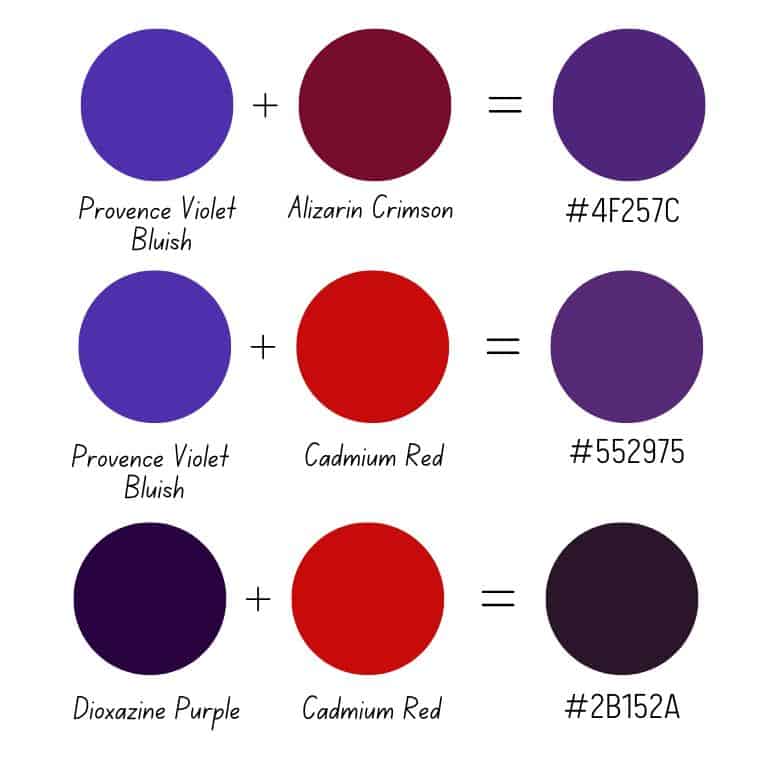
What Color is Red-Purple?
Red-purple is an intermediate color between red and purple on the traditional color wheel. This color, also known as magenta, is a mixture of purple and red.
Magenta is closer to red than purple because purple is an equal blend of red and blue.
Red-Purple Color Meaning
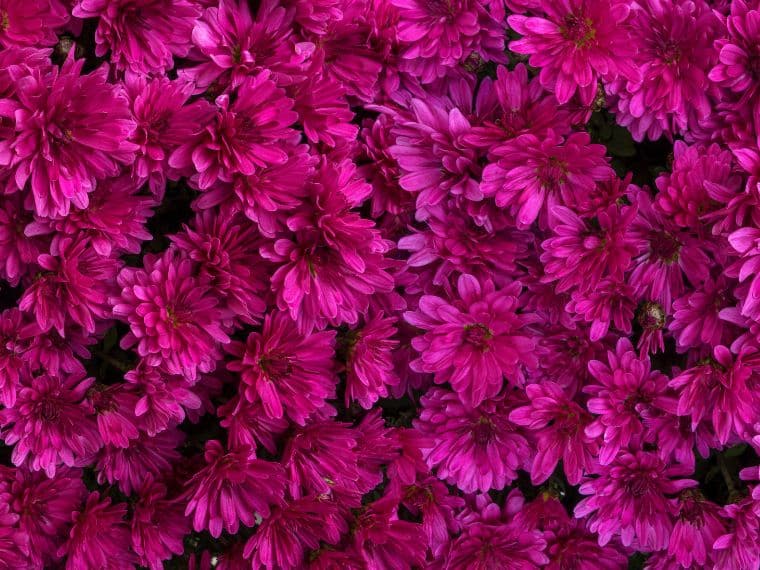
Some call it red-purple or red-violet, while others call it magenta. However, this mix of purple and red evokes compassion, self-respect, and support.
Magenta is associated with kindness, generosity, and compassion. It is the color that promotes understanding, harmony, and emotional balance.
Furthermore, magenta combines the warmth and energy of red with the creativity and ambition of purple.
Thus, magenta is a balanced mix of happiness, cheerfulness, and contentment.
Can You Mix Colors to Create Purple and Red?
Just as you see red and purple mixed together to make red-purple, other colors can also be combined to make purple or red.
Purple is a secondary color on the RYB color wheel. This means that it can be created by mixing two primary colors. So what colors make purple? The simple answer is red and blue. Mix them using an equal ratio, and you’ll get purple.
But what about red?
Red is a primary color on the RYB color model, meaning it cannot be created by mixing other colors. However, you can make red by using a subtractive mix from the CMYK color model.
So what colors make red? The short answer is magenta and yellow.
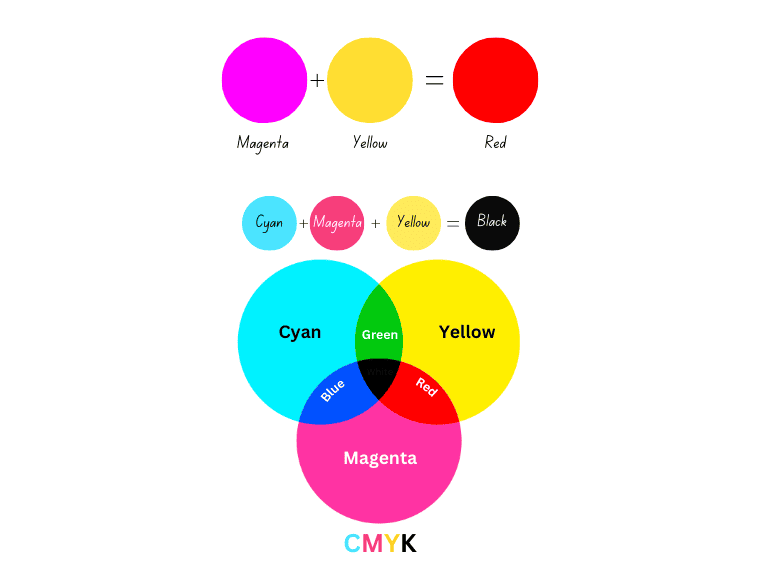
Red can be made by mixing magenta and red in equal amounts. This is a subtractive color mixing.
Why does the subtractive mixing of magenta and yellow make red? When mixed with magenta and yellow pigments, they absorb (subtract) different parts of the spectrum of white light.
When these two pigments are mixed, they absorb green and blue light while reflecting only red light.
In particular, magenta absorbs green wavelengths, and yellow absorbs blue wavelengths. Thus, this mixture cancels out all other wavelengths of light except red.
What Do Red and Purple Make When Mixing Lights?
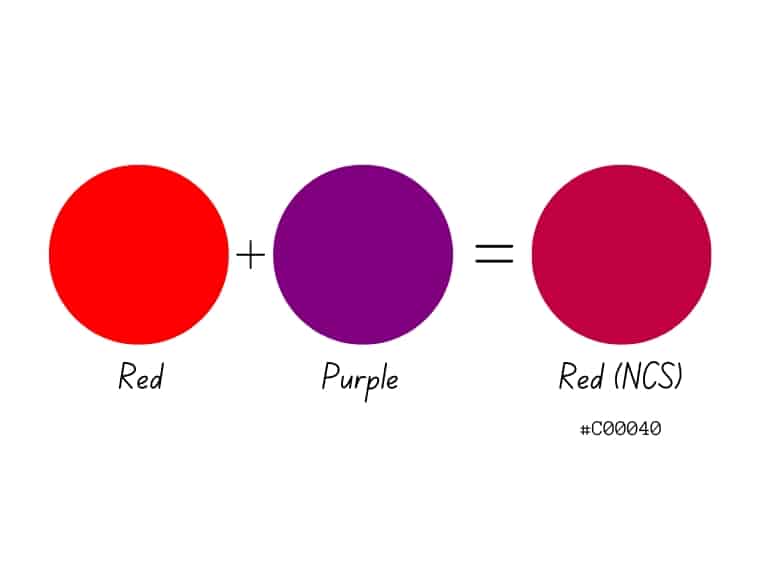
When it comes to lights, things change. So there is a color model that deals with light, and it’s called RGB. Its primary colors are red, green, and blue. These are considered the primary additive colors.
When you mix red and purple lights, the color produced is a dark reddish-magenta. Magenta is a secondary color in the RGB model resulting from mixing blue and red light equally.
How do Light Mixtures Work?
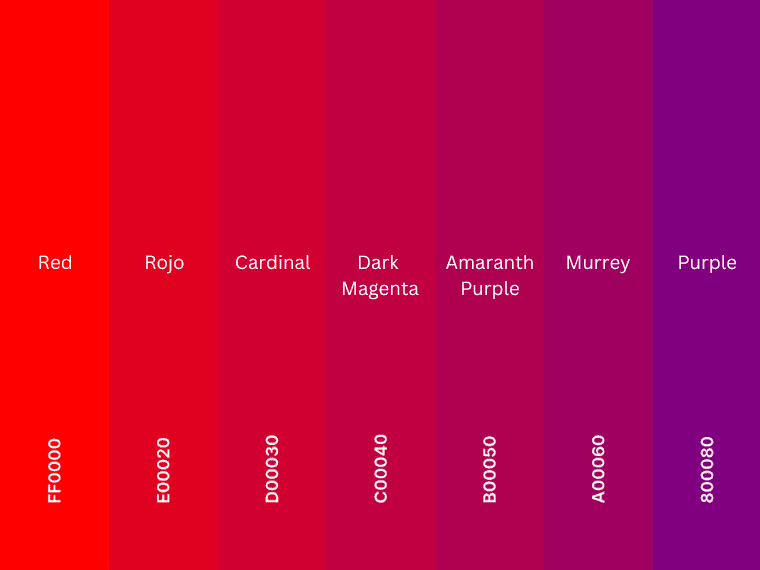
Mixing lights is additive color mixing.
This type of mixing combines different wavelengths of light to create other colors. This is different from subtractive mixing, which involves removing certain wavelengths of light from white light.
The additive mixture is used on all electronic displays, including computer monitors, laptops, tablets, TVs, and smartphones. All of these use small red, green, and blue pixels (also called sub-pixels) at different brightness levels to create colorful images.
Additive mixing starts with black (darkness) and brightens more with the overlapping of colored light.
Finally, the additive model creates white light by equally mixing the primary colors of light – red, green, and blue – at maximum brightness.
Is Purple the same as Violet?
Purple and violet are not the same color.
Violet is a spectral color, meaning it exists as a single wavelength of light. Moreover, violet has the shortest wavelength of visible light, at around 380 nanometers.
On the other hand, purple is a non-spectral color created by combining blue and red in equal parts.
Purple
Hex: #800080
RGB: 128, 0, 128
CMYK: 0, 100, 0, 50
Violet
Hex: #8F00FF
RGB: 143, 0, 255
CMYK: 44, 100, 0, 0
Do Red and Purple Always Make Magenta?
Whether you mix pigments or lights, red and purple mixed will yield red-purple or magenta. However, you will likely get a dark magenta in physics and light.
At the same time, the same mix of pigments will produce different warm shades of purple (red-purple).
Other mixes produce different colors in the world of physics vs. traditional art. For example, red and blue make purple in painting. On the other hand, the same mix of lights makes magenta.
On the RGB color wheel, purple is a mix of violet and magenta, between 270 and 300 degrees. Magenta is a secondary color created by mixing red and blue light. Violet, on the other hand, is a tertiary color created by mixing magenta and blue.
Do Red and Purple Go Together?
Red and purple clash when paired together, even if they are close on the color wheel. That’s because red is a warm color, while purple is cool.
But you need to know the color theory rules in order to break them.
Red and purple work well together if you choose the right tones. You can combine paler versions of purple and lighter versions of red.
For example, lavender goes well with blush. Eggplant goes well with burgundy. Furthermore, mauve pairs well with different shades of pink.
So, purple and red go well together, but it depends a lot on the tones you choose.
Also, the result of mixing the two, magenta, goes well with both red and purple.
F.A.Q.
Do Red and Purple Make Pink?
No, red and purple mixed together don’t make pink, but rather a warm purple. That’s because purple is a secondary color resulting from mixing red and blue in equal amounts. So when you blend red and purple, it’s like mixing two parts red and one part blue.
Do Red and Purple Make Violet?
No, red and purple mixed together do not make violet, but red-purple. This is an intermediate color on the color wheel, also known as magenta. Violet is made by mixing blue and purple in an equal ratio.

